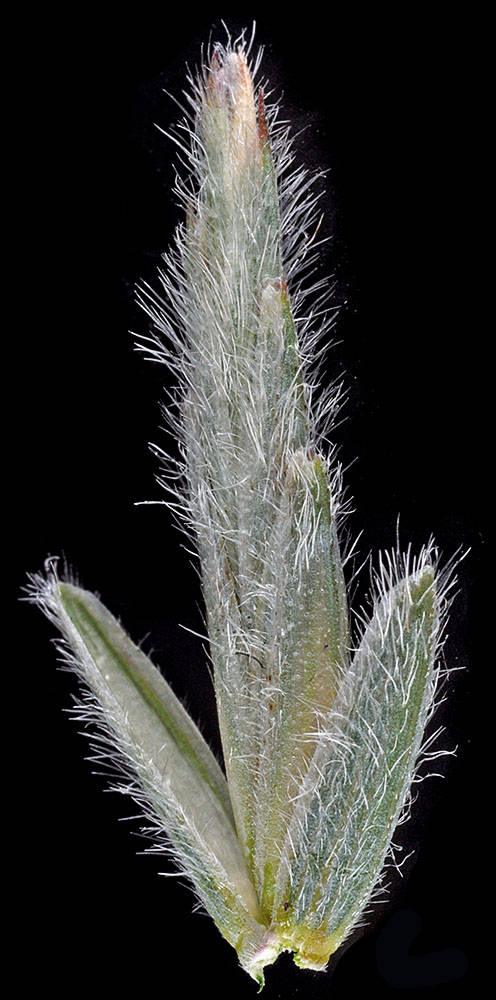Elymus lanceolatus
Elymus hirsutus
thickspike wheatgrass
northwestern wildrye
erect.
usually somewhat decumbent.
sheaths glabrous or pubescent;
blades 1.5–6 mm wide;
outer surfaces usually glabrous;
inner surfaces with appressed hairs.
sheaths glabrous and smooth but occasionally minutely scabrous or hairy;
blades 4–12 mm wide;
upper surfaces pilose or villous but occasionally puberulent or minutely scabrous.
3.5–26 cm; erect to slightly nodding, 1 spikelet per node but occasionally with 2 at a few nodes;
internodes 3.5–15 mm;
disarticulation above the glumes; beneath each floret.
6–20 cm, nodding to pendent, 2 spikelets per node or rarely with 3 at some nodes;
internodes 3–10(12) mm;
disarticulation above the glumes and beneath each floret.
8–31 mm, 1.5–3 times longer than the internodes, appressed, 3–11 florets, glabrous or hairy;
hairs to 1 mm.
12–20 mm, appressed to divergent, 2–4(7) florets.
5–14 mm, 50–75% the length of the adjacent lemmas, 0.7–1.3 mm wide, lanceolate, glabrous or hairy; smooth or scabrous, 3–5-veined; flat or weakly keeled;
keels straight;
margins narrow, tapering from the base or from beyond mid-length;
tips acute to acuminate, sometimes mucronate or short-awned.
(4.5)7–10(11) × 0.7– 1.5 mm, bases flat, occasionally hard for 0.5 mm;
veins usually evident, linear-lanceolate; entire, widening or parallel-sided above the base, 3–5-veined, usually scabridulous to scabrous;
veins occasionally hirsute beyond mid-length;
margins hyaline or scarious;
glume awns 1–10 mm; straight.
7–12 mm, glabrous to densely long-hairy; all hairs similar, sometimes scabrous;
tips acute to awned;
lemma awns; if present; to 2 mm; straight.
7–14 mm; smooth or minutely scabrous;
lateral veins hairy;
margins hairy beyond mid-length; marginal hairs 0.5–1 mm and longer than those elsewhere on the lemma;
lemma awns (2)8–30 mm, flexuous to moderately outcurving.
2.5–6 mm.
2–3.5 mm.
Elymus lanceolatus
Elymus hirsutus
3 subspecies.
Elymus lanceolatus is a strongly rhizomatous wheatgrass that lacks or nearly lacks awns. It is most similar to Pascopyrum smithii, which has more basally concentrated leaves and glumes that taper from near the base and have curved midveins. It is also similar to E. trachycaulus, which is cespitose, has consistently glabrous lemmas, and has glumes 75–100% as long as the lemmas.
Forest edges, thickets and grasslands near the coast and in coastal mountains. 0–1000m. CR, Est. WA; north to AK. Native.
The nodding spikes and ciliate lemma margins help identify Elymus hirsutus. The lemma margin hairs may be inconspicuous and should not be confused with the hairs sometimes present on the palea keels of Elymus species. Elymus hirsutus occasionally hybridizes with Elymus glaucus, Hordeum brachyantherum, and Leymus mollis.
Barbara Wilson, Richard Brainerd, Nick Otting
Barbara Wilson, Richard Brainerd, Nick Otting
- Local floras:
BC,
OR,
WA
- Local Web sites:
Flora NW,
PNW Herbaria
WildflowerSearch
iNaturalist (observations)
USDA Plants Database
- LBJ Wildflower Center
- SEINet
- Plants of the World Online
- Encyclopedia of Life
- Wikipedia
- Google Image Search
- Local floras:
BC,
OR,
WA
- Local Web sites:
Flora NW,
PNW Herbaria
WildflowerSearch
iNaturalist (observations)
USDA Plants Database
- LBJ Wildflower Center
- SEINet
- Plants of the World Online
- Encyclopedia of Life
- Wikipedia
- Google Image Search




